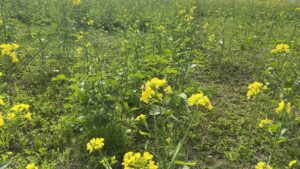परागण एक प्राकृतिक प्रक्रिया है जिसमें पौधों के नर भाग (पुंकेसर) से पराग कण (pollen grains) पौधों के मादा भाग (अंडाशय) तक पहुँचते हैं। यह प्रक्रिया पौधों के प्रजनन के लिए आवश्यक है, जिससे फल, बीज और नए पौधे उत्पन्न होते हैं।
मधुमक्खियों की परागण में भूमिका:
मधुमक्खियां परागण में सबसे महत्वपूर्ण परागणकर्ता (pollinators) मानी जाती हैं। उनकी भूमिका इस प्रकार है:
1. फूलों से पराग कण इकट्ठा करना:
मधुमक्खियां फूलों से पराग और मधुरस (nectar) इकट्ठा करती हैं। इस प्रक्रिया में पराग उनके शरीर से चिपक जाता है।
2. फूलों के बीच पराग का स्थानांतरण:
जब मधुमक्खी एक फूल से दूसरे फूल पर जाती है, तो वह पराग कण को मादा भाग (स्त्रीकेसर) तक पहुँचा देती है, जिससे निषेचन (fertilization) होता है।
3. पौधों की विविधता बढ़ाना:
मधुमक्खियां विभिन्न फूलों के बीच पराग स्थानांतरित करके पौधों की आनुवंशिक विविधता (genetic diversity) को बढ़ाती हैं।
4. फसलों की उत्पादकता में वृद्धि:
मधुमक्खियों की मदद से फसलों का परागण होता है, जिससे अधिक मात्रा में फल और बीज उत्पन्न होते हैं। यह खेती के लिए बहुत लाभदायक है।
महत्व:
• फसल उत्पादन का लगभग 70% हिस्सा मधुमक्खियों के परागण पर निर्भर करता है।
• अगर मधुमक्खियां ना हों, तो फसलों की उत्पादकता और पौधों का प्रजनन प्रभावित हो सकता है।
• पर्यावरण संतुलन बनाए रखने में भी मधुमक्खियां अहम भूमिका निभाती हैं।
मधुमक्खियों का संरक्षण और उनके प्राकृतिक आवास को सुरक्षित रखना न केवल शहद उत्पादन के लिए, बल्कि पूरे पारिस्थितिकी तंत्र के लिए भी जरूरी है।

